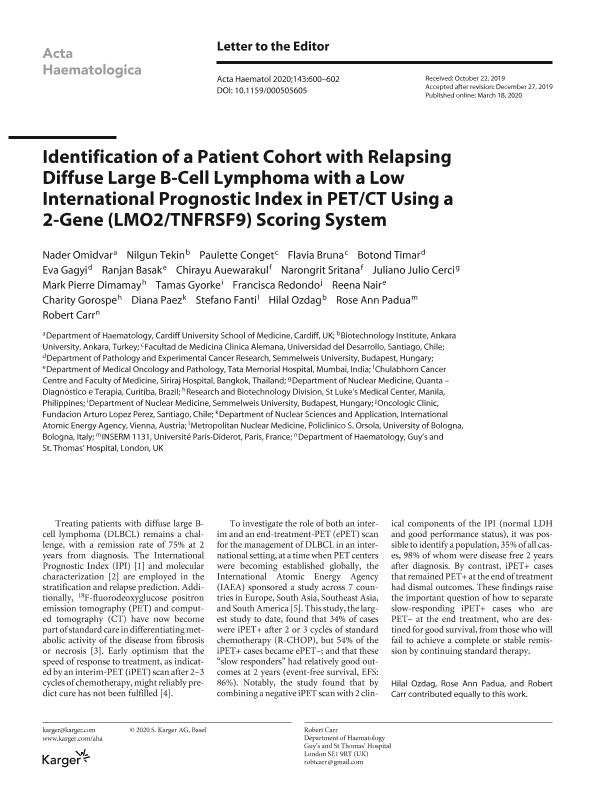Artículo
Identification of a patient cohort with relapsing diffuse large b-cell lymphoma with a low international prognostic index in pet/ct using a 2-gene (lmo2/tnfrsf9) scoring system
Omidvar, Nader; Tekin, Nilgun; Conget, Paulette; Bruna, Flavia Alejandra ; Timar, Botond; Gagyi, Eva; Basak, Ranjan; Auewarakul, Chirayu; Sritana, Narongrit; Cerci, Juliano Julio; DImamay, Mark Pierre; Gyorke, Tamas; Redondo, Francisca; Nair, Reena; Gorospe, Charity; Paez, DIana; Fanti, Stefano; Ozdag, Hilal; Padua, Rose Ann; Carr, Robert
; Timar, Botond; Gagyi, Eva; Basak, Ranjan; Auewarakul, Chirayu; Sritana, Narongrit; Cerci, Juliano Julio; DImamay, Mark Pierre; Gyorke, Tamas; Redondo, Francisca; Nair, Reena; Gorospe, Charity; Paez, DIana; Fanti, Stefano; Ozdag, Hilal; Padua, Rose Ann; Carr, Robert
 ; Timar, Botond; Gagyi, Eva; Basak, Ranjan; Auewarakul, Chirayu; Sritana, Narongrit; Cerci, Juliano Julio; DImamay, Mark Pierre; Gyorke, Tamas; Redondo, Francisca; Nair, Reena; Gorospe, Charity; Paez, DIana; Fanti, Stefano; Ozdag, Hilal; Padua, Rose Ann; Carr, Robert
; Timar, Botond; Gagyi, Eva; Basak, Ranjan; Auewarakul, Chirayu; Sritana, Narongrit; Cerci, Juliano Julio; DImamay, Mark Pierre; Gyorke, Tamas; Redondo, Francisca; Nair, Reena; Gorospe, Charity; Paez, DIana; Fanti, Stefano; Ozdag, Hilal; Padua, Rose Ann; Carr, Robert
Fecha de publicación:
12/2020
Editorial:
Karger
Revista:
Acta Haematologica
ISSN:
0001-5792
Idioma:
Inglés
Tipo de recurso:
Artículo publicado
Clasificación temática:
Resumen
Treating patients with diffuse large Bcell lymphoma (DLBCL) remains a challenge, with a remission rate of 75% at 2 years from diagnosis. The International Prognostic Index (IPI) [1] and molecularcharacterization [2] are employed in the stratification and relapse prediction. Additionally, 18F-fluorodeoxyglucose positron emission tomography (PET) and computed tomography (CT) have now become part of standard care in differentiating metabolic activity of the disease from fibrosisor necrosis [3]. Early optimism that the speed of response to treatment, as indicated by an interim-PET (iPET) scan after 2?3 cycles of chemotherapy, might reliably predict cure has not been fulfilled [4].To investigate the role of both an interim and an end-treatment-PET (ePET) scan for the management of DLBCL in an international setting, at a time when PET centers were becoming established globally, the International Atomic Energy Agency (IAEA) sponsored a study across 7 countries in Europe, South Asia, Southeast Asia, and South America [5]. This study, the largest study to date, found that 34% of cases were iPET+ after 2 or 3 cycles of standard chemotherapy (R-CHOP), but 54% of the iPET+ cases became ePET?; and that these ?slow responders? had relatively good outcomes at 2 years (event-free survival, EFS: 86%). Notably, the study found that by combining a negative iPET scan with 2 clinical components of the IPI (normal LDH and good performance status), it was possible to identify a population, 35% of all cases, 98% of whom were disease free 2 years after diagnosis. By contrast, iPET+ cases that remained PET+ at the end of treatment had dismal outcomes. These findings raisethe important question of how to separate slow-responding iPET+ cases who are PET? at the end treatment, who are destined for good survival, from those who will fail to achieve a complete or stable remission by continuing standard therapy.
Archivos asociados
Licencia
Identificadores
Colecciones
Articulos(IMBECU)
Articulos de INST. DE MEDICINA Y BIO. EXP. DE CUYO
Articulos de INST. DE MEDICINA Y BIO. EXP. DE CUYO
Citación
Omidvar, Nader; Tekin, Nilgun; Conget, Paulette; Bruna, Flavia Alejandra; Timar, Botond; et al.; Identification of a patient cohort with relapsing diffuse large b-cell lymphoma with a low international prognostic index in pet/ct using a 2-gene (lmo2/tnfrsf9) scoring system; Karger; Acta Haematologica; 143; 6; 12-2020; 600-602
Compartir
Altmétricas



